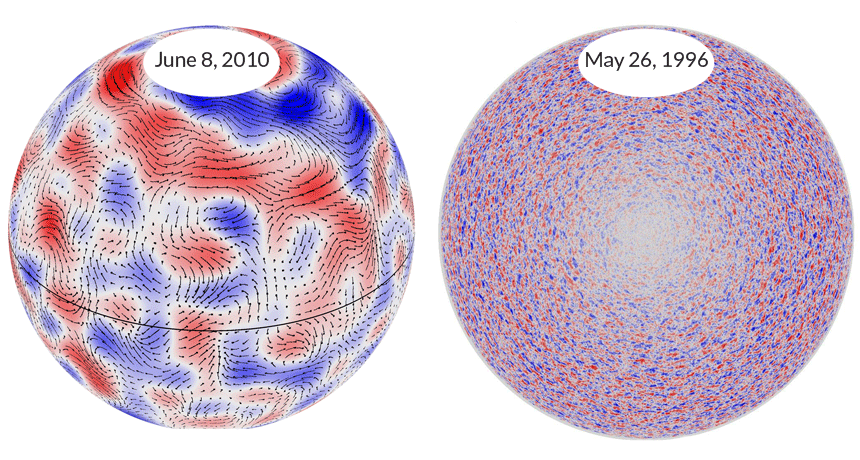Sun’s rotation driven by enormous plasma flows
Observations of giant structures support long-theorized heat transport mechanism

BIG SOLAR CELLS Giant, long-lived convective structures (left) move plasma on the sun’s surface. Earlier observations found only much smaller plasma flows covering the sun (right). In these illustrations, blue indicates plasma flowing east to west; red indicates west to east.
Courtesy of D. Hathaway/NASA
- More than 2 years ago
Massive, long-lasting plasma flows 15 times the diameter of Earth transport heat from the sun’s depths to its surface, according to a study in the Dec. 6 Science. The finding supports a decades-old explanation of why the sun rotates fastest at its equator.
In the outermost 30 percent of the sun, known as the convective zone, rising plasma carries heat generated by nuclear fusion in the sun’s guts. Once at the surface, much of the plasma’s energy radiates into space; the cooler, denser plasma then sinks, driving further convection and creating circulating loops called convection cells. Some especially massive convective structures, called supergranules, can last up to 24 hours and have diameters greater than Earth’s.
In 1968, scientists theorized that even longer-lived and larger convection cells, big enough to span the entire convective zone, are necessary to maintain the fast rotation researchers had long observed around the sun’s equator; without such cells, the poles should rotate faster than the equator. Since then, scientists have sought such giant cells in telescopes’ observations of the sun.
In the new study, a team led by David Hathaway of NASA’s Marshall Space Flight Center in Huntsville, Ala., looked for these elusive convection cells using the agency’s most sophisticated sun watcher, the Solar Dynamics Observatory. The researchers measured shifts in the wavelengths of light radiating from the sun’s plasma as it flowed toward or away from Earth, and used the shifts to compute plasma velocities over the solar surface. These velocities revealed the positions of supergranules, a feat Hathaway had already accomplished with data from other observatories. This time, however, Hathaway and his colleagues were able to use many closely timed observations to see that supergranules travelling across the solar surface were pushed by even larger plasma flows.
The scientists found that many of these flows reappeared roughly once every 27 days, the time it takes for a spot on the sun’s equator to rotate and thus reappear in view from Earth. The fact that these flows could last for multiple solar rotations strongly suggests that they are the long-lasting giant convection cells researchers have been looking for, Hathaway says. His team also found that giant cells appeared to transport fast-rotating plasma toward the equator and slow-rotating plasma toward the poles, confirming other predictions.
The study is the most compelling claim anyone has made about detecting giant convection cells, says Mark Miesch, an astrophysicist at the National Center for Atmospheric Research in Boulder, Colo., who has built computer simulations of solar convection. But, he adds, “I wouldn’t call it a slam dunk.”
Hathaway himself acknowledges that the observations don’t entirely agree with leading theories. Computer simulations predict longer-lived convection cells near the equator and shorter-lived ones near the poles; Hathaway’s team found the opposite. “I have sent copies of the paper out to some of my theorist friends,” he says, “and they’re still scratching their heads a bit.”
GO WITH THE FLOW Long-lasting plasma flows appear in red and blue in this animation, which portrays data from four solar rotations. Some flows persist for several months; these patterns are especially visible near the sun’s north pole. Scientists think these flows keep the sun’s equator rotating faster than its poles.
Credit: Courtesy of D. Hathaway/NASA







